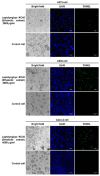Naturally Occurring Functional Ingredient from Filamentous Thermophilic Cyanobacterium Leptolyngbya sp. KC45: Phytochemical Characterizations and Their Multiple Bioactivities
- PMID: 36552645
- PMCID: PMC9774153
- DOI: 10.3390/antiox11122437
Naturally Occurring Functional Ingredient from Filamentous Thermophilic Cyanobacterium Leptolyngbya sp. KC45: Phytochemical Characterizations and Their Multiple Bioactivities
Abstract
Cyanobacteria are rich in phytochemicals, which have beneficial impacts on the prevention of many diseases. This study aimed to comprehensively characterize phytochemicals and evaluate multifunctional bioactivities in the ethanolic extract of the cyanobacterium Leptolyngbya sp. KC45. Results found that the extract mainly contained chlorophylls, carotenoids, phenolics, and flavonoids. Through LC-ESI-QTOF-MS/MS analysis, 38 phenolic compounds with promising bioactivities were discovered, and a higher diversity of flavonoids was found among the phenolic compounds identified. The extract effectively absorbed the harmful UV rays and showed high antioxidant activity on DPPH, ABTS, and PFRAP. The extract yielded high-efficiency inhibitory effects on enzymes (tyrosinase, collagenase, ACE, and α-glucosidase) related to diseases. Interestingly, the extract showed a strong cytotoxic effect on cancer cells (skin A375, lung A549, and colon Caco-2), but had a much smaller effect on normal cells, indicating a satisfactory level of safety for the extract. More importantly, the combination of the DNA ladder assay and the TUNEL assay proved the appearance of DNA fragmentation in cancer cells after a 48 h treatment with the extract, confirming the apoptosis mechanisms. Our findings suggest that cyanobacterium extract could be potentially used as a functional ingredient for various industrial applications in foods, cosmetics, pharmaceuticals, and nutraceuticals.
Keywords: bioactivity; cyanobacteria; ethanolic extract; functional ingredient; phytochemicals.
Conflict of interest statement
The authors declare no conflict of interest.
Figures







Similar articles
-
Therapeutic properties in Tunisian hot springs: first evidence of phenolic compounds in the cyanobacterium Leptolyngbya sp. biomass, capsular polysaccharides and releasing polysaccharides.BMC Complement Altern Med. 2016 Dec 13;16(1):515. doi: 10.1186/s12906-016-1492-3. BMC Complement Altern Med. 2016. PMID: 27964734 Free PMC article.
-
Antioxidant, metabolic enzymes inhibitory ability of Torreya grandis kernels, and phytochemical profiling identified by HPLC-QTOF-MS/MS.J Food Biochem. 2019 Dec;43(12):e13043. doi: 10.1111/jfbc.13043. Epub 2019 Sep 10. J Food Biochem. 2019. PMID: 31506967
-
Antioxidant activities and phytochemical constituents of Antidesma thwaitesianum Müll. Arg. leaf extracts.J Integr Med. 2017 Jul;15(4):310-319. doi: 10.1016/S2095-4964(17)60334-0. J Integr Med. 2017. PMID: 28659236
-
Total Bioactive Contents, Metabolic Profiling, Docking Studies, Antioxidant and Enzyme Inhibition Activities of Convolvulus Arvensis L. and Multivariate Analysis to Unravel a Potential Herb as Natural Resource for Pharmaceutical Industry.Chem Biodivers. 2022 Nov;19(11):e202200521. doi: 10.1002/cbdv.202200521. Epub 2022 Oct 17. Chem Biodivers. 2022. PMID: 36149393
-
Bioactivities of phytochemicals present in tomato.J Food Sci Technol. 2018 Aug;55(8):2833-2849. doi: 10.1007/s13197-018-3221-z. Epub 2018 Jun 1. J Food Sci Technol. 2018. PMID: 30065393 Free PMC article. Review.
Cited by
-
Fast DPPH antioxidant activity analysis by UHPLC-HRMS combined with chemometrics of tempeh during food processing.Metabolomics. 2024 Nov 13;20(6):130. doi: 10.1007/s11306-024-02190-3. Metabolomics. 2024. PMID: 39538093
-
Assessment of the Nutritional Composition, Antimicrobial Potential, Anticoccidial, and Antioxidant Activities of Arthospira platensis in Broilers.Biology (Basel). 2025 Apr 7;14(4):379. doi: 10.3390/biology14040379. Biology (Basel). 2025. PMID: 40282245 Free PMC article.
-
Innovative Eco-Friendly Microwave-Assisted Rapid Biosynthesis of Ag/AgCl-NPs Coated with Algae Bloom Extract as Multi-Functional Biomaterials with Non-Toxic Effects on Normal Human Cells.Nanomaterials (Basel). 2023 Jul 24;13(14):2141. doi: 10.3390/nano13142141. Nanomaterials (Basel). 2023. PMID: 37513152 Free PMC article.
-
Quorum quenching of phenolic compounds from Leptolyngbya spp. MACC 32 via downregulation of the periplasmic receptor LuxP in Vibrio harveyi: Hinting a putative mechanism.World J Microbiol Biotechnol. 2025 Jun 27;41(7):233. doi: 10.1007/s11274-025-04378-8. World J Microbiol Biotechnol. 2025. PMID: 40571855
-
Ultrasound-Assisted Deep Eutectic Solvent Extraction of Antioxidant and Anti-Colorectal Cancer Proteins from Spirulina Biomass: Process Intensification, Characterization, and Bioactivity Evaluation.Antioxidants (Basel). 2025 Mar 19;14(3):365. doi: 10.3390/antiox14030365. Antioxidants (Basel). 2025. PMID: 40227477 Free PMC article.
References
-
- Kumar Y., Tarafdar A., Kumar D., Saravanan C., Badgujar P.C., Pharande A., Pareek S., Fawole O.A. Polyphenols of edible macroalgae: Estimation of in vitro bio-accessibility and cytotoxicity, quantification by LC-MS/MS and potential utilization as an antimicrobial and functional food ingredient. Antioxidants. 2022;11:993. - PMC - PubMed
-
- WHO . Diet, Nutrition and the Prevention of Chronic Diseases. WHO; Geneva, Switzerland: 2003. [(accessed on 14 November 2021)]. (WHO Technical Report Series 916). Available online: https://apps.who.int/iris/handle/10665/42665.
-
- Barba-Ostria C., Carrera-Pacheco S.E., Gonzalez-Pastor R., Heredia-Moya J., Mayorga-Ramos A., Rodríguez-Pólit C., Zúñiga-Miranda J., Arias-Almeida B., Guamán L.P. Evaluation of biological activity of natural compounds: Current trends and methods. Molecules. 2022;27:4490. doi: 10.3390/molecules27144490. - DOI - PMC - PubMed
-
- Almendinger M., Saalfrank F., Rohn S., Kurth E., Springer M., Pleissner D. Characterization of selected microalgae and cyanobacteria as sources of compounds with antioxidant capacity. Algal Res. 2021;53:102168. doi: 10.1016/j.algal.2020.102168. - DOI
-
- Lomakool S., Ruangrit K., Jeerapan I., Tragoolpua Y., Pumas C., Srinuanpan S., Pekkoh J., Duangjan K. Biological activities and phytochemicals profiling of different cyanobacterial and microalgal biomass. Biomass Conv. Biorefin. 2021:1–17. doi: 10.1007/s13399-021-01974-0. - DOI
LinkOut - more resources
Full Text Sources
Miscellaneous

